Election issues: What students are saying
February 10, 2010 by Justin Langille · Leave a Comment
An audio-slideshow that asks questions about how students feel about student government and life at Kwantlen.
Eagles basketball throws down back-to-back barnburners
February 6, 2010 by Justin Langille · Leave a Comment
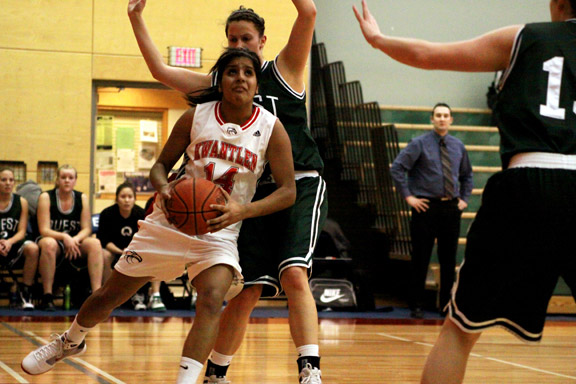
Eagles forward Shmyla Thandi takes it to the net in the second quarter, helping to secure an Eagles lead. (Justin Langille photo)

Emily Wright powers past Quest Kermodes guard Brittany Harteveld in the third quarter, earning the Eagles a 40-31 lead over the Kermodes. (Justin Langille photo)
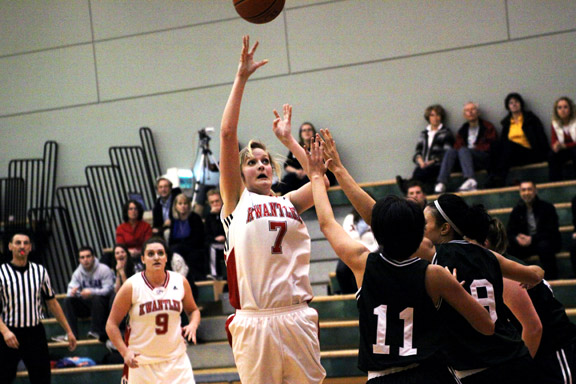
Ali Randa throws a shot above Kermodes guard Charlotte Lau and forward Courtney Harpur, giving the Eagles a 49-38 advantage at the end of the third quarter. (Justin Langille photo)
By Kyle Vinoly
It was a tense fourth quarter for the Kwantlen Eagle’s Women’s basketball team, as they defeated the Quest University Kermodes of Squamish 62-59 Friday. After dominating the first half of their match-up against Quest, competition heated up and the game came down to a nail-bitting final two minutes.
“Into the fourth quarter, we stopped playing defense,” said Eagle’s guard Emily Wright, who played 37 minutes and drained one of the trio of three-point shots made by the Eagles. “We always play well for the first three quarters and then the fourth quarter we don’t do well.”
Eagle’s coach Gary Pawluck said that the girls have had many close finishes this year but thinks it’s helped make them a better team.
“We came out with real intensity today,” said Pawluck. “We missed a few easy shots in the second half, and [Quest] stepped up and made some good shots.”
The women also faced off against Quest Saturday, in an attempt to secure a spot in the B.C. Provincial Championships. (Results will follow.)
“I don’t think anyone ever picked Kwantlen to make the playoffs, ever,” said Eagles forward Shmyla Thandi, who posted 11 points in the night and secured a double-double, getting 10 defensive rebounds. “It’s exciting, it motivates me for the next game.”
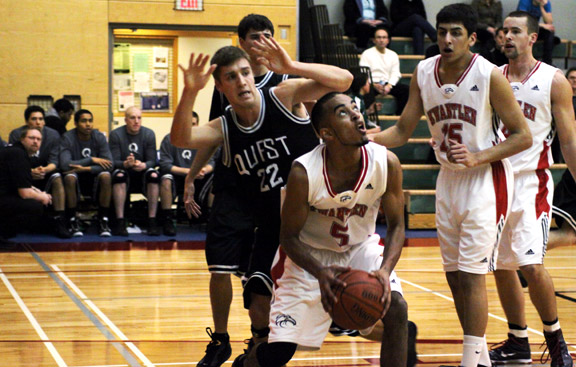
Eagles forward Ali Bosir looks for a way to the net halfway into the first quarter. (Justin Langille photo)
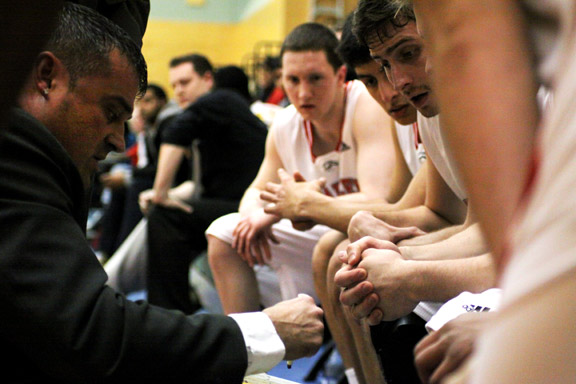
Seconds from the end, Coach Robbie Love draws out a play that will secure Kwantlen’s hard fought win over the Kermodes. (Justin Langille photo)

Varinder Singh gets airborne as he celebrates the Eagles win. (Justin Langille photo)
By Kyle Vinoly
A high-pressure free throw from Eagle’s guard Mike Davis sealed a win for the Eagle’s in the final 30 seconds of the fourth quarter of their Friday game against Quest University Kermodes of Squamish 65 to 64.
The Eagle’s were ahead by 10 points at the end of the first quarter but the men from Quest fought back in the second and third quarters. The lead changed 12 times before the Eagles finally won, 65-64.
VIU sinks Eagles basketball teams Saturday
February 1, 2010 by Justin Langille · Comments Off

Eagles gaurd Ali Randa pushes past Marniners forward Katie Pearson, left, and Shayna Worthington for a chance at the ball in the second quarter. (Justin Langille photo)
Both Kwantlen Eagles basketball teams suffered tough losses against Victoria Island University Mariners at home in Surrey Saturday.
The Mariners put the women’s team through the wringer first, coming out with a 91-47 win over the Eagles.
Eagles forwards Shmyla Thandi and Chantelle Doerksen led in points for the Eagles with 15 and nine points.
The teams tied in three-point shot efficiency.
On the men’s side, things weren’t much better, with the Mariners men’s team taking an 87-66 win over the Eagles.
Forward Ali Bosir and guard Mike Davis managed to pull together 16 points each for the Eagles, but their hard work wasn’t enough to come back from an 83-61 Mariners lead. The Eagles led the Mariners in three point shots 18-15.
Gary Pawluk, coach of the Eagles women’s team says that while the team showed a strong effort the night before, only losing by nine, he wants his team to be playing a higher, more consistent level.
Next Friday and Saturday, the Eagles will face off against the Quest University Kermodes, games that Pawluk says will determine whether the Eagles make it into the playoffs.
“We gotta work hard this week to succeed this weekend,” said Pawluk. “It’s one of our most important weekends of the year. We have to adjust to their style of play and their strengths and take care of their strengths accordingly and try to utilize ours a little better.”

Eagles forward Varinder Singh tries to evade guard Rylan Higginson while looking for a way through Mariners' defence. (Justin Langille photo)
Green Wednesdays are more than a free movie ticket
January 13, 2010 by Justin Langille · Leave a Comment

This Wednesday, Jan.1, Kwantlen's School of Horticulture will host its first Green Wednesday of 2010. (Justin Langille photo)
Film screenings and discussion forums on contemporary issues are a common part of university culture, but Gary Jones thinks his evening series of documentary films and speakers at Kwantlen’s Langley campus is more than just a clichéd fixture of campus life.
For the last two years, Jones, chair of Production Horticulture at Kwantlen’s Langley campus, has been organizing a monthly evening of films and discussion on sustainable agriculture, called Green Wednesdays.
Beginning in October and ending in March, the event happens on the second Wednesday of every month in one of the labs that Jones teaches in at the Langley campus.
Jones began the event as a government-funded speaker series in the fall of 2008, but government funding was eventually curtailed, forcing him to look elsewhere for material to inspire discussion.
Luckily, people involved in the Green Ideas Network, a Burnaby-based environmental advocacy organization, were looking for a new venue for to the Surrey Environmental Film Festival. Jones linked up with the network, and began hosting evenings of film, discussion and networking around an array of environmental issues.
So far this year, Jones and his students have shown features dealing with peak oil, energy use and climate change, all films that highlight the need for people to consider more sustainable lifestyles. This Wednesday, Jones, his students and some members of the Langley community will gather to watch Good Food, a 2008 film about the resurgence of small-scale, family-run farming initiatives in the Pacific Northwest of the United States.
Participation in setting up and promoting the evening has become required coursework for students in Jones’ Sustainable Horticulture class. Students help organize the event and do assignments based on the films being shown.
“It’s a good way for the students to get involved and to make connections out there with the organic community and the public who turn out,†said Jones.
Jones is enthusiastic about the potential for exposing people to the broader issues that affect the environment. He is aware that the evening has an outreach potential, in that it brings people to the campus who might not otherwise.
“One of my desires for the Green Wednesdays was to use it as a link between the community and the school, so people in Langley or Surrey or wherever could come on to the campus when they might otherwise not do so,†said Jones.
“The evenings are bringing new information to the students, but they’re also getting the students to share their information with the public. It’s a good way of extending the education to the wider community,†said Jones.
Guided by the invisible hand of design: Signage tells commuters more than just destination
January 10, 2010 by Justin Langille · Leave a Comment
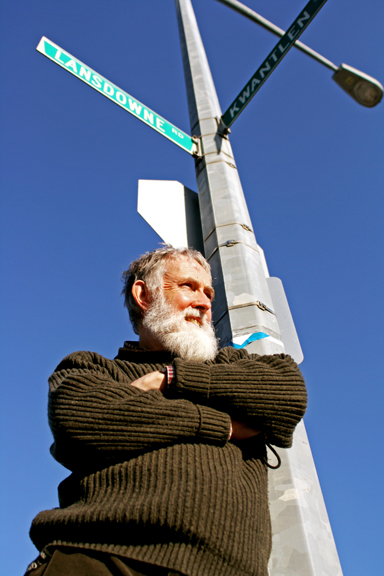
Ken Hughes of Kwantlen's graphic-design program says that standardized road-signs like those above, may become obsolete in the future. (Justin Langille/Kwantlen Chronicle)
Ken Hughes can’t stand it when British street signs aren’t there to do their job.
“Sometimes you’ll come around this traffic circle, looking for the sign that’s always there and there isn’t one. And you go, ‘You bastards! Why did you do that to me?’â€
An English expatriate who teaches graphic design at Kwantlen’s Richmond campus, Hughes has an intimate understanding of how important road signs are to modern transportation.
Over the past 10 years, Hughes has been studying signage by photographing lettering inscribed in stone, painted on walls and printed on signs in various places during his travels in Europe.
He knows that street signs, or “wayfinding graphics†in the graphic-design world, have meaning beyond just telling you where to go.
“[Road] signage makes…you feel like you’re being looked after,†said Hughes. “It’s almost like there’s an invisible human being saying, ‘If you want to go to Scotland from London, just follow the signs; you’ll get there. Just follow the signs. Have faith.’â€
Street signs, or “directional signs†to City of Vancouver engineers, aren’t celebrated like parks or bike lanes, but are considered a valuable and constantly evolving community service by those who work with them.
Street-name blades, the smaller signs attached to posts on street corners that tell you you’re at Hastings and Victoria, have changed in type size and reflectivity in recent years, enabling safer travel through the city, said Winston Chau, a transportation engineer for Vancouver.
The Transportation Association of Canada (TAC) dictates the overall design of signs in Vancouver, ensuring they conform to a standard: white, sans-serif lettering on black background, bordered by high-grade reflective tape.
Despite TAC’s guidelines, some Vancouver communities have reclaimed their signs and used them to express unique cultural identities.
Business-improvement associations in some of Vancouver’s popular neighbourhood districts have applied to the city to have their blades designed to represent their neighbourhood’s distinct cultural identity, said Chau.
Signs with Chinese characters and a distinct 1940s style distinguish Vancouver’s Chinatown, and signs for the Marpole area near South-West Marine Drive are printed in the language and symbols of the Musquem first nation, who historically inhabited the area. The newly refurbished Cambie Village, the Punjabi market at Main Street and 49th Avenue and posh Kerrisdale have also customized their street-sign blades to express character or historical importance.
All Vancouver street-signs, including pesky regulatory signs telling you where not to park downtown, are printed in the city’s sign shop, located at the National Works Yard just behind Pacific Central Station. Responsible for producing everything from venue signs to traffic redirection signs during the Olympics, the shop is shouldering its fair share of work for the games.
In the little spare time employees have, the shop also prints individual signs for people as part of their Street Signs for Everyone program. People can order plastic or metal signs, ranging in price from $50 to $90, featuring the names of any Vancouver street.
Nick Kazawa, an engineering department employee responsible for managing the shop, said that tourists and locals used to order replica signs of favorite Vancouver destinations such as Robson Street.
These days, however, people are more interested in having their own names printed on the signs.
Hughes said that these sorts of personal affiliations with street signs, and the cultural pride expressed by Vancouver’s custom neighbourhood signs, are evidence that people want street signs to be more than plain infrastructure.
Some designers, such as England’s Why Not Associates, are attempting to embed street signs into walls and sidewalks instead of littering the landscape with more poles, shapes and junk to look at, said Hughes.
Along with wayfinding information, the group is integrating historical information about the people and cities where the signage is based.
“It’s not just telling you where things are, but it’s telling you about what’s there. To me that is developing a sense of civic pride and knowledge of your district,†said Hughes.
“Especially if you’re younger…sometimes we’re so caught up in working on newer technologies that the history of a place escapes us,†said Hughes.
â€Picking up information on where you live, just because you have to see it everyday walking down the street…to me, that’s a great idea.â€
A changing game: Digital technology has changed our musical lives
January 10, 2010 by Justin Langille · Leave a Comment
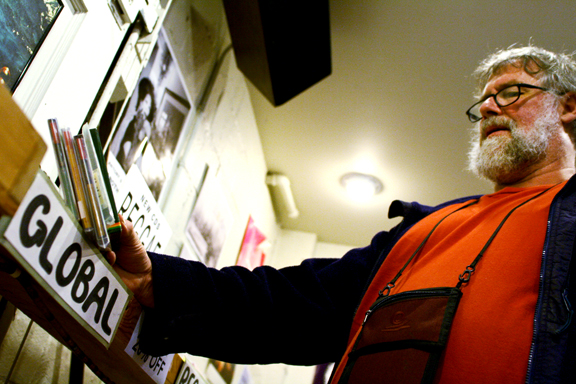
Slocan Valley resident Charles Van Toorn picks up world music at Zulu.(Justin Langille/Kwantlen Chronicle)
In his 10-year run as general manager of Zulu Records, Nic Bragg has seen his customers’ connection to music transformed drastically during the revolution brought on by MP3s and the Internet.
“It doesn’t really have a value anymore,†Bragg said. “The relationship has changed. Your music tastes are constantly evolving and you’re constantly consuming, as well as purging music.â€
The devaluation of music has been encouraged by the transition of traditional music journalism into the online forum, Bragg said. He said that taste-making websites like Pitchfork.com have encouraged lifestyle branding of artists.
“I went to Chicago to their [Pitchfork’s] music festival and basically, it’s like a Wal-Mart of independent culture. Shoe companies and other companies are paying to be at the festival to market to the demographic,†he said.
Bragg is skeptical about Pitchfork’s willingness to turn music fans into customers for corporate wares, a common practice in commercial culture, but guarded against in grassroots music circles. Most of them that is.
On the other side of Vancouver, Edo Van Breeman, owner of label Unfamiliar Records, is ecstatic about Pitchfork’s marketing power.
Unfamiliar Records is the Canadian home of Pitchfork favourites Japandroids. Last year, Van Breeman sent Pitchfork a press release for the punk band’s debut album, Post-Nothing. The album was immediately given the prestigious Best New Music title, the site’s gold seal of approval. Overnight success ensued.
“You could attribute, at least preliminarily, 100 per cent of their success to that review,†said Van Breeman. “Pitchfork is a unique case. They’re like the online, modern Rolling Stone.â€
Although Van Breeman believes that Pitchfork’s support was pivotal to Japandroids’ success, he also thinks that if the band hadn’t gone on the road to meet fans and tour as much as it did afterwards, it wouldn’t have done so well.
“You also have a lot of best-new-music designations that don’t do as well as Japandroids. I think that has a lot to do with how the band has toured and how the band is marketed. It’s not like you get the review and bingo, you’re a big band. You have to work for it as well,†Van Breeman said.
Bragg concedes that around 2006, when Zulu Records started to see a decline in sales because of music pirating and online sales, a renaissance in live music began. As musicians could count less and less on traditional income from the sales of LPs and CDs, they hit the road to deliver their art in person and revive the relationship between bands and their fans.
Speaking to BBC News in 2007, Stuart Galbraith, the UK managing director of LiveNation (one of the biggest concert promotion companies in the UK and North America), said that the sales of festival tickets in the UK were surging “beyond belief,†and that the live music scene in the UK was doing better than he could ever remember.
“Live music is the ultimate experience,†Galbraith told the BBC. “It’s not bootleggable, you can’t replicate it, you can’t steal it, and you can’t mimic that experience of actually standing at a gig the roar of the crowd, the smell of the greasepaint.â€
Vancouver blogger Quinn Omori would agree: he would even take it one step further. A UBC IT technician by day, Omori runs From Blown Speakers, a modest blog that presents an exhaustive list of nearly every show going on in Vancouver.
He believes that the amount of music available online hasn’t lessened the value of music for fans, but has allowed people to find music that inspires them to make music themselves, perhaps the most intimate relationship one can have with music.
“Anything you can possibly think of, anything that you might want to hear or want to emulate, you can find,†Omori said. “And you can probably find a bunch of people wanting to do the same thing.â€
Back at Zulu records, Bragg and his coworkers are still managing to get by. Pitchforkapproved artists, Canadian independent music and timeless favorites like Zeppelin and Hendrix still sell, and vinyl is making a moderate comeback among the hipster set.
Bragg said that Zulu could expand into literature and video games, the way HMV has in recent years, but he thinks the chemistry is good enough for now.
“It’s a specialized thing now. The things that you’re looking for here, you can’t find in every corner store. The record store could become pretty much like Urban Outfitters if it really wanted to, but we’re not interested in that.â€
Outdoor cinema a breath of fresh air
January 10, 2010 by Justin Langille · Leave a Comment
Barb Floden has helped to create a monster, one that emerges at night in summer and is adored in communities throughout Metro Vancouver.
For the last five years, the Vancouver Board of Parks and Recreation communications director has organized the Monsters in the Meadow film events, a series of free public movies screened outdoors at Ceperly Meadow, located close to Second Beach in Stanley Park.
The annual event brings hundreds of people out to watch classic B-rated monster movies in the ominous surroundings after dark.
This year, Monsters in the Meadow screened The Blob, the morbid tale of an alien life form that eats everything that gets in its way.
Floden said that despite some rain, more than 500 people showed up with blankets, popcorn and costumes to take in a bit of old-fashioned, drivein-inspired fun.
She said that event provides a great opportunity for people to come out for some affordable fun that isn’t the usual programming offered by the park board.
“Recreation is not just sports or fitness oriented,†she explained. “It’s anything to do with engaging people at the community level and bringing them together in a positive way, and arts and culture is also part of our mandate. And this is not the traditional public art and crafts and painting.â€
Since Monsters in the Meadow began in 2004, localities throughout the Lower Mainland have promoted similar free movie screenings.
With the help of Fresh Air Cinemas, an events promotion and logistics company, White Rock, Langley, Burnaby and Coquitlam all hosted public movie screenings this past summer. The cities provide the right park
or accessible space and Fresh Air comes in and sets up sound, projection and a huge inflatable screen for viewing.
Floden acknowledged that sponsorship and support for free movie events like these come from many sources, and the public support is obviously there.
She said that the West End Community Association’s showing of Momma Mia at Harbor Green Park brought out more than 1,000 people.
In Surrey, free movie events have taken on a life of their own over the past five years.
Bonnie Burnside, manager of special events and communication for the Surrey Downtown Business Improvement Association, said that she has watched their annual summer movie events grow from a small get together near the Gateway SkyTrain station to a series of full-fledged community parties at Holland Park. Burnside said that this past summer, more than 2,000 people came out each night to see family films such as The Lion King and Hannah Montana: The Movie.
Burnside said she thinks that the events fill a void in summer-events programs in Surrey and provide members of the diverse community with an opportunity to come out and meet their neighbours.
“In our area, there weren’t a lot of events going on in the summertime and there particularly wasn’t a lot of events going on in the evening,†said Burnside. “What we wanted to do was show everybody that this was a great place to come and be a part of an event.â€
Public response to the films has been overwhelmingly positive, but Burnside said that it is a costly venture that comes with some strings attached.
This summer, Burnside was able to finance the Holland Park movie events, pre-show entertainment included, for about $23,000. However, she knows the cost for next year will be higher and that it will be difficult to come up with the extra funding from her budget.
In Vancouver, Floden’s concerns have less to do with funding and more to do with organization and legalities. Responsibility for advertising for the movies was shared between business associations, community associations and Fresh Air Cinema, which made it difficult to find out where and when the events were happening.
To make matters worse, she said that many community associations bought the wrong public-screening licenses, which prevented them from advertising the names of the films screened. She said that things will be organized differently next year.
“We’ll do a group marketing effort that can show people ‘here is all of the events happening in our parks this summer,’ because people don’t really care who sponsors them, they just want to go see a free movie,†said Floden with a laugh.
“They can come out and just hang out at the park with their friends and neighbours and don’t have to open their wallets at all.â€
Health community ready for outbreak, but virus’s unpredictable nature could ruin plans
January 10, 2010 by Justin Langille · Leave a Comment
Although he sounds fatigued, Dr. James Lu’s voice can only be described as confident when he speaks about the state of the H1N1 outbreak in B.C.
“I think the current concern is making sure the population has the correct information in terms of the level of risk or severity of the pandemic at this point in time, as we understand it,†Lu, the medical health officer for Vancouver Coastal Health in Richmond, said in an interview with the Kwantlen Chronicle.
In its Sept. 22 website bulletin, the Ministry of Health Services reported that 48 B.C. residents had contracted the virus so far. Among those, 21 had been sent to intensive care units and six people with preexisting medical conditions had died from the illness.
Lu said the provincial and federal governments, in conjunction with the B.C. Centre for Disease Control and Vancouver Coastal Health, have followed the guidelines set out by the Public Health Agency of Canada in the B.C Pandemic Influenza Pre-paredness Plan.
Developed in 2005 by the B.C. Ministry of Health and the B.C. Centre for Disease Control, the 200-page document outlines the steps officials are to follow before, during and after a flu-pandemic outbreak, and is consistent with national and international pandemic preparedness protocol, according to the introduction.
Lu said that because of the plan, provincial health authorities were able to quickly and effectively track and monitor the outbreak of the virus, as well as educate the public about how to avoid getting sick. The current rates of death and sickness due to H1N1 in the Lower Mainland are comparable to those for the common flu.
“It’s quite reasonable,†he said of the impact of the H1N1 on B.C residents.
“It’s not any different from what we would expect from seasonal influenza. The sense we have right now is that the health-impact severity is similar to the seasonal flu instead of the 1918 Spanish flu that people are recalling. The majority of the cases are mild.â€
The Spanish flu was a pandemic that killed over 20 million worldwide in 1918 and 1919.
Historians believe that during that pandemic, Vancouver had one of the highest rates of death of any North American city, when 795 of an estimated 4,890 infected people died, according to a June 12, 2009 Vancouver Sun article.
The H1N1 virus has made headlines around the world for being an aggressive flu strain that has killed as many as 3,486 people as of Sept. 18, according to the World Health Organization weekly H1N1 update.
However, Lu insisted that the strain isn’t as aggressive as he and his colleagues had initially thought it was.
“You probably have about 50,000 hospitalizations or so each year from the flu and you would probably would have 4,000 to 5,000 deaths a year from the flu in Canada. I think we’re doing something to help keep H1N1 in that range, but the virus also isn’t as virulent as we feared initially,†he said.
Even so, Lu is advising those who are concerned about contracting H1N1 to make an effort to get the H1N1 vaccine from their local health authorities as it becomes available locally.
According to Lu, the vaccine will gradually become available within the next week, as it is being produced in batches, and is prioritized for vulnerable B.C. populations.
Irene Lanzinger, president of the B.C. Teachers Federation, said that strategies for preventing the spread of flu among students – such as hand washing and covering coughs or sneezes – are being implemented by teachers and schools as students settle into classes.
However, Lanzinger also said that she doesn’t know of any specific plans or strategies put in place by provincial health authorities to protect students.
“The ministry of health and the ministry of education need to make sure that school boards are prepared for what might happen,†she said.
“I don’t know whether they have given instructions to school boards. We really get the sense that there is a little bit of a wait-and-see attitude out there because nobody knows for sure how bad it’s going to be. Having said that, people need to put some plans in place in case something does happen.â€
Lu is optimistic that the H1N1 outbreak in B.C. won’t evolve into a greater crisis, but he is also realistic about the unpredictability of the virus as the flu season hits.
“Because most of us don’t have any immunity to it, I wouldn’t be surprised if come the fall, we do have a large number of people who become ill,†he said.
“Most of it will not need hospitalization or need to be seen by a doctor, but more people may become sick with the flu,†he said. “It may turn out that yes, this virus may be causing a little more severe illness in a healthy person, but it’s hard to sort that out now.â€
Choir offers more than just Christmas spirit
December 7, 2009 by Justin Langille · 1 Comment
Snow hasn’t fallen on Metro Vancouver yet this winter, but it won’t be long from now if Gail Suderman has her way with the season.
For the last nine years, Suderman, the director of voice and choral studies at Kwantlen’s Langley campus, has spent most of her time teaching Kwantlen students to sing classical music.
But in her spare time, she indulges in her love of more contemporary music, helming the Good Noise Vancouver Gospel Choir, one of only four community choirs devoted to singing gospel music in Vancouver.
Every year, Suderman and the choir perform Christmas carols and pop music favorites at the Christ Church Cathedral in downtown Vancouver for two nights before Christmas to get people in the spirit of the holidays.
She recalls that the choir ended last year’s show just as Vancouver’s picturesque white Christmas began.
“The memories that particularly stick in our mind are when snow is involved,”said Suderman. “The last night [last year] right as people were walking out, the snow started falling. It just added to that Christmas energy, that spirit of it.”
The concerts usually end up selling out every year and are wildly popular with Vancouverites looking for a unique musical experience around the holiday, said Suderman.
This year, the choir will perform its Glory of Christmas concerts for two sold-out nights on Dec. 11 and Dec. 12 at the cathedral. There will be another performance during the afternoon of Dec. 13 at the Frasierview Church in Richmond.
Suderman, a classically trained singer, and her colleague Marcus Mosely, started the Good Noise Choir in 2004 out of a mutual love for the energy and celebratory spirit of gospel. After doing some workshops with people in the community and being inundated with requests to keep going, she held auditions and did the first Christmas concert at the Christ Church Cathedral that December.
“It took off just like wildfire, in terms of people being excited about it and people coming out to concerts,”said Suderman.
Since its debut, the choir has grown from 42 to 75 members and includes people of all ages and walks of life. Some people come from as far as Abbotsford to train with the choir throughout the year. Members have to audition to join the choir, but the choir is non-denominational, which makes it open to anyone in the Lower Mainland who wants to sing.
“It’s a bit of a microcosm of what real life is like,” said Suderman. “It’s a great example of this diverse group of people coming together, creating this sort of unified sound through the singing. It has a really good energy.”
When not performing Christmas carols, the choir performs at events such as the Vancouver Folk Festival and has its own concert series that runs throughout the year at Christ Cathedral Church. Years of hard work paid off recently, said Suderman, when the group got a chance to perform for superstar record producer David Foster, who produces albums for the likes of Celine Dione and Michael Buble.
Suderman admits that the Good Noise choir enjoys popularity in the Lower Mainland, but that there isn’t as much of a culture around gospel music in Vancouver as there as there is in the United States, where the music has ethnic and cultural roots in African-American culture.
Vancouver is home to more classical and church-based choirs, but only a few popular music, or contemporary music choirs, the category that she feels Good Noise belongs to, said Suderman.
“It’s not that we feel isolated in terms of the choir itself,”said Suderman. “We are a little bit unique. I wouldn’t say that people are surprised that there are gospel choirs in Vancouver area. Because it’s unique, people take an interest in it. People say. ‘Ah, this is kind of different, let’s check it out.’”
This year, Suderman has invited three Lower Mainland music industry mainstays to join the choir for the holiday rejoicing. Kate Hammett-Vaughn, Karin Plato and Jennifer Scott, known as the Jazz Divas, will join the choir onstage to celebrate the holiday spirit.
Gospel is a music of celebration, which makes the Christmas holidays the perfect time for the Good Noise choir to rile up audiences and help Canadians shake off their reputation for being subdued at concerts.
“They love it,” Suderman said of the audience that shows up for the Christmas concerts. “It’s different than if you went to a classical concert, where you would sit quietly and be polite. For these [Christmas concerts], clapping along, singing along, it’s all part of it. It’s audience participation and people love, love that aspect.”
Profile: Still life with end times
December 4, 2009 by Justin Langille · Leave a Comment
Nostradamus still makes the front page of the Weekly World News now and then, but an apocalyptic event has yet to arrive to end life on earth.
That hasn’t stopped Robert Gelineau from revealing what the possible end of modern society might look like some day.
A painting and drawing instructor in Kwantlen’s fine arts department for over 10 years, Vancouver resident Gelineau spends his spare time creating scenes from a potential post-apocalyptic world on canvasses in his Gastown studio.
Inspired by classical still life painting and the shock value of horror films, Gelineau works diligently to develop detailed scenes of natural disaster that depict the end of human society and our contemporary world.
Chronicle photographer Justin Langille visited Gelineau in his studio to discuss the ideas behind his work and the problems involved in teaching painting to students in era when the lure of technology has pulled the study of art into a state of disarray.


